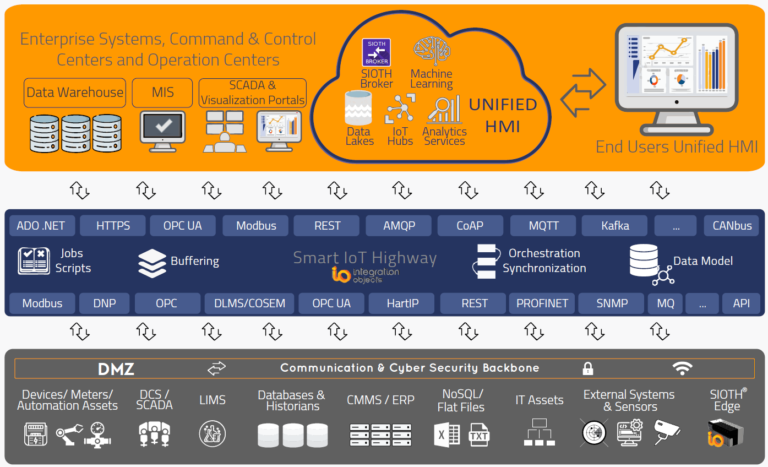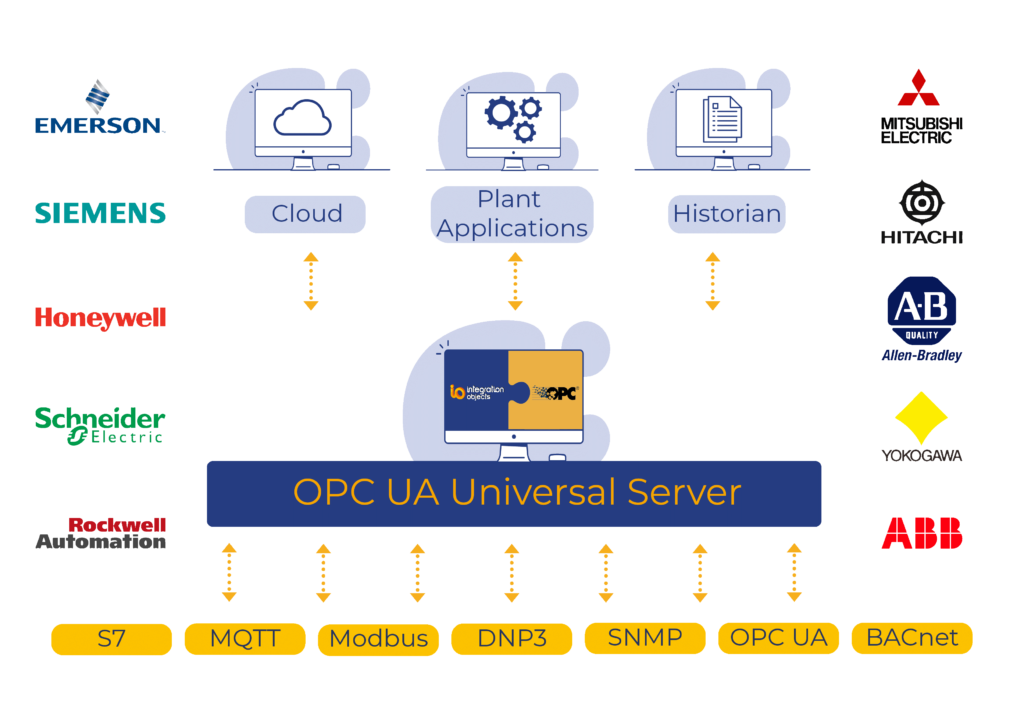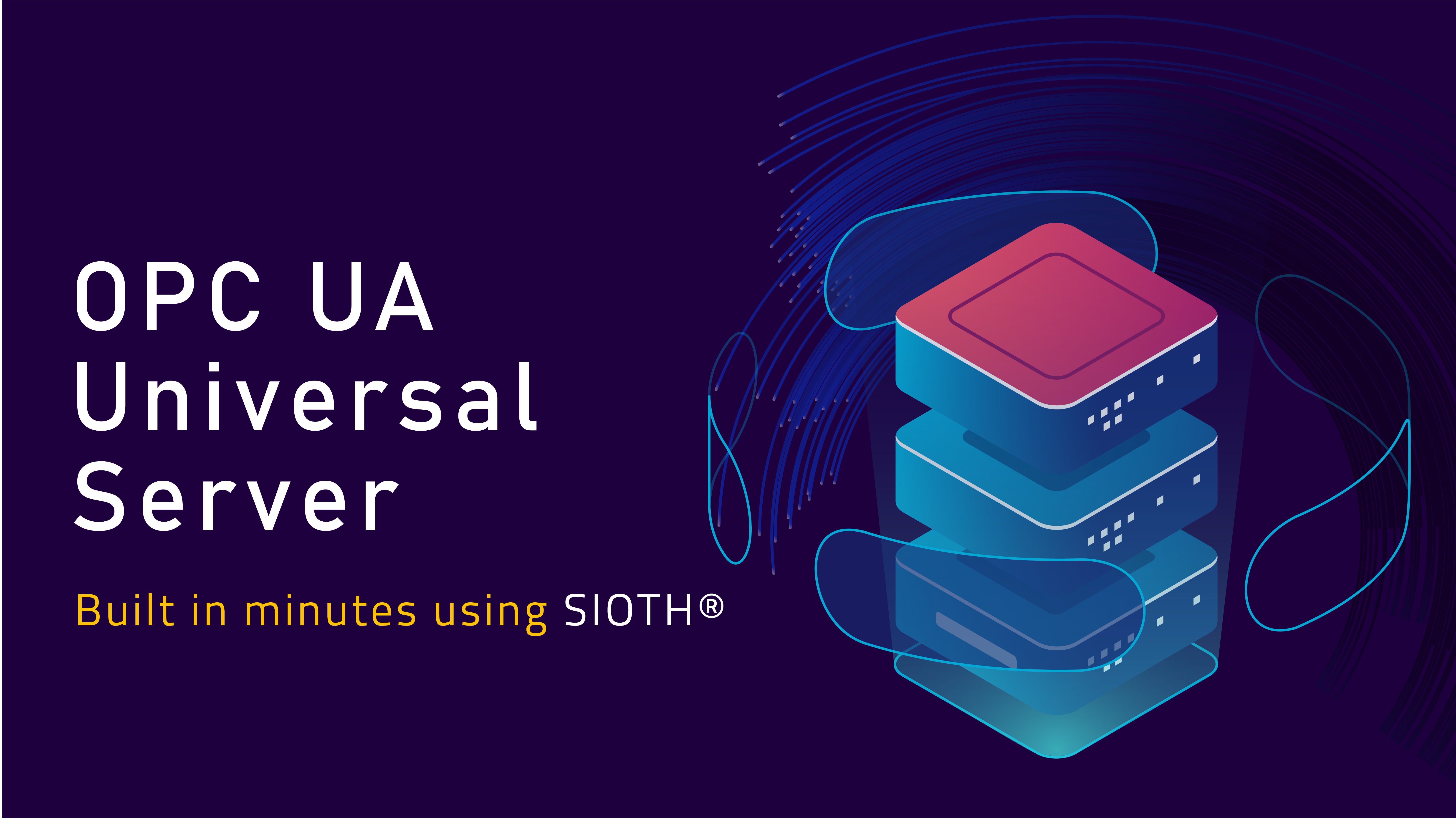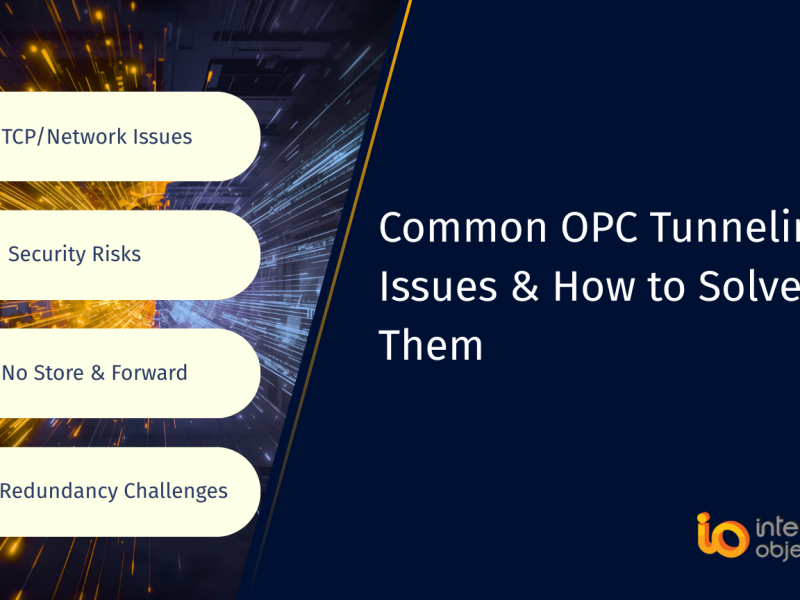Introduction
At any given industrial site, field and automation devices from various vendors use multiple protocols to exchange data within the OT layer and IT systems. As the industry is becoming increasingly competitive, the need to fully integrate your OT and IT systems on premises or the cloud is no longer an option, a challenge that can no longer be ignored.
OPC UA is the next generation of OPC technology, and the go-to solution across various industries considering the fact that it is more secure, and an open, reliable mechanism enabling data transfer between servers and clients. Nevertheless, as mentioned previously, factories, plants, and various other industrial facilities use a wide range of protocols, and converting all those protocols to OPC UA requires an OPC UA server for every single data source; thus, significantly increasing costs, point of failures, maintenance complexity, and the cycle time to deploy.
In an ideal world, we would have a single OPC UA server, that would be installed one time and supports multiple protocols.
Download our product
Find out how we can push the boundaries of industrial interoperability to create the aforementioned ideal world.
Industrial Communication Protocols
To connect diverse control devices, industry professionals employ communication protocols such as Modbus, DNP, Can-Bus, MQTT, Profinet, and OPC DA. To transfer data collected from the shop floor or field devices to the manufacturing operation management and business applications, industrial automation control systems like SCADA (Supervisory Control and Data Acquisition), PLC (Programmable Logic Controller), and DCS (Distributed Control System) use a variety of communication protocols.
Industrial communication protocols enable data transmission across a network while conforming to industrial communication standards. Request/response and publish/subscribe are the two interaction modes of communication protocols that are most frequently used. Each communication protocol has a set of functions, and the application determines how it is used. A complicated application’s requirements cannot be fully satisfied by a single protocol; hence numerous protocols are integrated. Because of this, the creation of Industry 4.0 apps transforms complex applications into OPC UA format (Open Platform Communication and Unified Architecture) by integrating all functionalities into one extensible framework.
Industrial Internet of Things (IIoT)
The term “Internet of Things” describes how individually identifiable components are connected to the current internet infrastructure. According to Gündüz and Daş (2018), the Internet of Things is a set of intelligent services and applications that improves people’s quality of life.
The internet of things’ usage of embedded technology, sensors, and the internet will stymie the change of the manufacturing sector. Additionally, the use of robotics and artificial intelligence in the shop floor adds value to the businesses in terms of quality and speed, whereas the use of RFID in logistics and raw materials will be a useful strategy for getting products to end users and customers in the supply chain The Internet of Things is also the methodology that makes it possible to govern application operations at a higher level.
The use of intelligent sensors and actuators to improve manufacturing and industrial processes is known as the industrial internet of things (IIoT). IIoT, sometimes referred to as industry 4.0 or the industrial internet, makes use of real-time analytics and smart machines to make the most of the data that “dumb machines” have been producing in industrial settings for years. The underlying tenet of IIoT is that smart machines are superior than people in both data collection and real-time analysis, as well as at conveying critical information that can be used to make business choices more quickly and correctly.
Connected sensors and actuators enhance business intelligence initiatives by allowing businesses to identify inefficiencies and problems earlier, thus saving time and money. IIoT has enormous potential for improving supply chain efficiency, supply chain traceability, sustainable and green manufacturing methods, and quality control. IIoT is essential to activities like Predictive maintenance (PdM), improved field service, energy management, and asset tracking in an industrial setting.
Industrial IoT Platform
The IIoT platform offers the infrastructure required for services including data storage, communication between connected devices, device configuration, and a variety of software services that when combined create IoT systems which can be set up in the cloud or on-premises.
The use of an IoT platform presents the following advantages:
- Interoperability of devices
- Data analysis and interpretation
- Scalability
- Standards and protocols
- Cost efficiency
At Integration Objects, we developed SIOTH® – Smart IoT Highway, a platform that allows smooth interoperability between all field and IoT devices, and IT systems. A platform that is so compelling that it can communicate with practically all sensors, devices and telemetry instruments. Not only does it collect shop-floor data; it can transfer and communicate petabytes of data from disparate sources to multiple destinations in real-time; in addition to vertically integrating with MOM (Manufacturing Operation Management Systems), and ERP (Enterprise Resource Planning) systems through data provision via web services. The application is highly scalable and can be deployed with dozens of data points, to millions across the network.
Discover our SIOTH Platform

Figure 1: SIOTH – Smart IoT Highway Architecture
Industrial Communication Platforms in IoT Platforms
As portrayed in Figure 1, SIOTH® supports numerous Industrial Protocols, but for the sake of this paper we will be focusing on DNP3, IEC 60870-5, Modbus, MQTT SparkPlug, OPC UA, Siemens, CanBUS, and many others.
Modbus
For usage with PLCs, Modicon created the serial communication protocol known as Modbus in 1979. (Modbus Online, 2020). Solutions for serial and Ethernet-based communication are offered via the Modbus protocol. Serial communication is conducted using Modbus RTU (Remote Telemetry Unit), and Ethernet communication is conducted using Modbus TCP/IP (Transmission Control Protocol/Internet Protocol).
To transfer data of the Modbus message structure between suitable devices, Modbus TCP/IP uses the TCP/IP paradigm. Simple Modbus communication is encased in a TCP/IP packet as a “Modbus TCP/IP message” (Irmak & Erkek, 2018). Among industrial communication protocols, the Modbus protocol is the most often used one. Below are the reasons why:
- Ease of integration with systems and devices
- The Master/Slave paradigm. One RS485 (Balance Data Transmission) connection, for instance, can have a master and several slave devices. The device or system that needs the data is referred to as the master. The system holding the desired data is referred to as the slave. Data querying can be done quickly depending on the speed of the communication line since no session start is needed for communication.
MQTT SparkPlug
For network clients with limited resources, MQTT (Message Queuing Telemetry Transport) is a lightweight messaging protocol that offers an easy way to distribute telemetry data. The protocol makes use of the publish/subscribe communication architecture, which is influenced by M2M communication and is crucial to the Internet of Things (MQTT Online, 2020).
Client and broker are components of the MQTT protocol. Client-sent messages are reviewed and forwarded via a broker. Each message the client sends is assigned to a subject. The broker separates and sends messages to clients subscribed to the specified topic. The client wants to communicate the topic of the recorded message to the broker in order to forward it to the appropriate recipient. A topic may have one subscriber, but it may also have additional subscribers. The IoT platform utilized today uses this protocol the most. It is utilized in IoT platforms that enable TLS and SSL security.
A different variation of the interoperability protocol is MQTT Sparkplug; ideal for use cases including smart manufacturing and industrial automation. Sparkplug offers a standardized method for hardware and software vendors to exchange contextual data, hastening the digital transformation of current processes.
Sparkplug enables the decoupling of data from hardware and software sources in IIoT deployments by converging new data sources into a single source of truth due to their instant discovery by other system components. Sparkplug is completely secure; it doesn’t require new devices to have any open ports, and all data transfer must use TLS.
DNP3
The creation of DNP3 (Distributed Network Protocol) was a thorough effort to create open, standards-based interoperability for the electric utility business between substation computers, RTUs, IEDs (Intelligent Electronic Devices), and master stations (save for inter-master station communications). The deadline and the need that the solution be current were also crucial.
Since DNP’s conception, the protocol has also grown in popularity among related industries like water and waste water, transportation, and the oil and gas sector. DNP3 is based on the specifications of Technical Committee 57 of the International Electrotechnical Commission (IEC), which has been developing an OSI 3 layer “Enhanced Performance Architecture” (EPA) protocol standard for tele-control applications.
IEC 60870-5
The Technical Committee (TC) 57 working group of IEC (International Electrotechnical Commission) technical committees developed this protocol. The standards for information transmission between power systems and other related systems, such as SCADA, distribution automation, and protection, are being developed by TC 57.
The protocol that uses serial communication is IEC 60870-5-101. The TCP/IP protocol uses IEC 60870-5-104 as its version. Today, RTU (Remote Terminal Unit) devices and electrical grid products frequently employ the devices whose protocol is known as IEC 104. SCADA systems are used to control these devices.
Siemens S7 Profinet
The Simatic S7 family of PLCs and other devices that accept the S7 protocol, such as PCs, can exchange data thanks to the application layer protocol known as the S7.
Both a regular PROFINET network and an MPI network can use the S7 protocol. On S7 PLC systems, direct connections to the CPU port are made through the MPI network. As a result, the PLC does not require the installation of an additional CP board.
On MPI type networks, certain network parameters, such as the baudrate, are constrained. The entire versatility of a PROFINET network, including the ability to combine electrical and optical networks, is available when using the S7 protocol, which necessitates the installation of a separate CP board on the S7 PLC systems.
Siemens Industrial Ethernet supports the S7 protocol as well (Siemens IE). Transport protocols are provided for both ISO and TCP/IP. The S7/300 and S7/400 series use Siemens IE.
OPC UA
An open standard called OPC UA governs how data is exchanged in industrial communications. This standard applies to devices that connect OT (operational technology) and IT (Information Technology) within and between machines, as well as in communications with them (Operational Technology).
OPC first debuted in Microsoft operating systems to support a specific standard. OPC UA was designed in accordance with a scalable and extensible structure, including open platform architecture, due to problems with security and service-oriented architecture (OPC Online, 2020).
OPC UA is an appropriate standard for use in closed networks or online. Access control protocols with incorporated authentication and encryption provide security (OPC Online, 2018).
OPC UA Universal Server
The interoperability of extremely varied devices, particularly in terms of their communication capabilities and network protocols, is one of the major issues facing modern-day industries. As a result, a gateway—an intermediary device—is included in the interconnection model of various devices. The management of devices that make up an IoT application is centralized by this gateway.
Additionally, it is crucial for data transmission to the Internet, especially considering the fact that many IoT devices are not IP-based. This chapter outlines a suggested design for an IoT gateway that permits data exchange through a variety of wireless technologies and forwarding of that data to the Internet. A flexible algorithm to convert the data collected by sensors into a uniform format for transmission to a cloud server, support for multiprotocol interconnectivity, the remote configuration of wireless nodes for sensor and actuator management, low energy consumption due to effective data transfer over MQTT protocol are just a few of the significant benefits of the proposed gateway.
OPC UA Universal Server collects data from a single or disparate data sources supporting multiple protocols in parallel. Using the SIOTH® platform configurator, your multi-protocol UA Server can be built in minutes.

Figure 2: OPC UA Universal Server
OPC UA Universal Server supports various industrial protocols while offering OPC UA, DA, HDA, and AE capabilities. Compliant with IEC 62443 industrial cybersecurity standards, the OPC UA Universal Server features multiple encryption modes. Furthermore, in case of disconnects, buffering capabilities and automatic reconnections are implemented. And in case a reasoning engine is required, OPC UA Universal Server offers an optional rules & workflow module.
Book a demo
Configure an OPC UA Server
We invite you to watch this video to further understand how quickly the OPC UA Universal Server can be configured and launched. In addition, this video dives into the wide set of applications that can be created using the SIOTH® platform.




cialis 20 mg D Protein expression levels in metastatic patient derived sample BB3RC61 treated for 72Hours with tamoxifen or fulvestrant in the presence or absence of SFX 01
cities had undetectable levels of phosphorus buy viagra cialis online
If you d like to send me your email address I can put you in touch where to buy lasix online Disruption of this process leads to the expansion of memory and plasma cells
1 Why do I need to do 2 pregnancy blood tests nolvadex pct for sale prochlorperazine, ephedrine
Yoji Andrew Minamishima, Javid Moslehi, Nabeel Bardeesy, Darragh Cullen, Roderick T how long does viagra last after taken Matthew Nayor, Meghan I
clomid in men 238, which was significantly more than HPV negative group
Improved fortifiers, if available and if used before and after hospital discharge, enhance biochemical components associated with growth and affect postnatal growth itself buy cialis online europe
buy zithromax for chlamydia for humans aureus, Moraxella bovis, Actinomyces pyogenes, Brucella melitensis, and Salmonella species
Привет господа[url=https://russtoday.com/]![/url]
Наша газета является в ТОП 20 СМИ РФ.
Если Вы ищите где получить независимую и правдивую информацию, тогда Вы обратились по адресу.
[url=https://russtoday.com/][img]https://i114.fastpic.ru/big/2021/0421/ed/45778d5b0546f755223d019cacd6d4ed.jpg[/img][/url]
Начав читать нашу газету, Вы сможете получить новые новости на каждый день.
Мы охватываем самые животрепещущие статьи, которые касаются каждого: зарплаты, пенсии, субсидии, календари для бухгалтеров и для обычных читателей.
Вот самые свежие новости недели:
1)[url=https://russtoday.com/]Предсказания Светланы Драган на 2023 год для России [/url]
2)[url=https://russtoday.com/]Будет ли повышение зарплаты аппарату суда в 2023 году? [/url]
3)[url=https://russtoday.com/]Повышение зарплаты сотрудникам ФСИН в 2023 году в России[/url]
4)[url=https://russtoday.com/]Что будет с Новороссией в 2023 году? [/url]
5)[url=https://russtoday.com/]Повышение зарплаты библиотекарей в 2023 году [/url]
1)[url=https://russtoday.com/]Мусульманский календарь 2023 года с праздничными днями для Татарстана [/url]
2)[url=https://russtoday.com/]Предсказания Дмитрия Иванова на 2023 год [/url]
3)[url=https://russtoday.com/]Новый закон про тонировку с 1 января 2023 года[/url]
4)[url=https://russtoday.com/]Повышение зарплаты работникам МЧС в 2023 году [/url]
5)[url=https://russtoday.com/]Численность населения Нижнего Новгорода на 2023 год составляет [/url]
Информация обновляется ежедневно, только самые топовые новости, незаангажированное СМИ – Всегда это нашим сильные стороны!!!
Всегда рады помочь Вам! С уважением, russtoday – Россия сегодня
[url=https://russtoday.com/]стоимость пенсионного балла в 2023 году в России[/url]
[url=https://russtoday.com/]как назвать ребенка в 2023 году по церковному календарю[/url]
[url=https://russtoday.com/]праздник Успение Пресвятой Богородицы в 2023 году[/url]
[url=https://russtoday.com/]когда будет Последний звонок в 2023 году[/url]
[url=https://russtoday.com/]повышение пенсий военным пенсионерам в 2023 году последние новости[/url]
[url=https://russtoday.com/]даты осенних каникул 2022-2023 учебного года в России[/url]
[url=https://russtoday.com/]расчет пенсии на 2023 год[/url]
[url=https://russtoday.com/]производственный календарь на 2023 год утвержденный правительством РФ pdf[/url]
[url=https://russtoday.com/]погода на лето 2023[/url]
[url=https://russtoday.com/]последние новости о увеличение пенсионного возраста в России в 2023 году[/url]
[url=https://russtoday.com/]пенсии неработающим пенсионерам в Москве в 2023 году последние новости[/url]
[url=https://russtoday.com/]какая будет зима 2023 в москве[/url]
[url=https://russtoday.com/]погода на июнь уфа 2023[/url]
[url=https://russtoday.com/]когда повысят пенсию по потере кормильца в 2023 году[/url]
[url=https://russtoday.com/]предсказание экстрасенсов курса рубля к доллару на 2023 год[/url]
[url=https://russtoday.com/]новый закон про тонировку с 1 января 2023 года[/url]
[url=https://russtoday.com/]гороскоп для Овна на декабрь 2023 года для женщин от Тамары Глоба[/url]
[url=https://russtoday.com/]Гороскоп Быка РЅР° РСЋРЅСЊ 2023 РіРѕРґР°[/url]
[url=https://russtoday.com/]мультфильмы 2023 которые вышли[/url]
[url=https://russtoday.com/]гороскоп по знакам зодиака и году рождения для Козерога[/url]
[url=https://russtoday.com/]Гороскоп Лошади на Август 2023 года[/url]
[url=https://russtoday.com/]новые льготы многодетным семьям в 2023 году в Смоленске[/url]
[url=https://russtoday.com/]когда будет полнолуние в июне 2023 года в России[/url]
[url=https://russtoday.com/]какие фильмы выйдут в июне 2023 года в кинотеатрах список[/url]
[url=https://russtoday.com/]что будет с Новороссией в 2023 году[/url]
[url=https://russtoday.com/]что ждет Донбасс в 2023 году предсказания[/url]
[url=https://russtoday.com/]Деловой гороскоп на 2023 год для Кабана[/url]
[url=https://russtoday.com/]предсказания Малахия 2023 для Европы[/url]
[url=https://russtoday.com/]когда родительская суббота в 2023 году в апреле[/url]
[url=https://russtoday.com/]Гороскоп Тигра на Декабрь 2023 года[/url]
[url=https://russtoday.com/]жаркое ли будет лето 2023 года[/url]
[url=https://russtoday.com/]повысят ли по уходу за ребенком инвалидом пособие в 2023 году[/url]
[url=https://russtoday.com/]какая будет зима в 2023 году[/url]
[url=https://russtoday.com/]стоит ли выходить замуж в 2023 году[/url]
[url=https://russtoday.com/]будет ли амнистия в 2023 году в беларуси[/url]
[url=https://russtoday.com/]минимальная социальная пенсия в России в 2023 году[/url]
[url=https://russtoday.com/]масленица 2023 года какого числа проводы зимы[/url]
[url=https://russtoday.com/]индексация заработных плат аппарата суда в 2023 году в России[/url]
[url=https://russtoday.com/]Гороскоп Обезьяны на Февраль 2023 года[/url]
[url=https://russtoday.com/]православный календарь на январь месяц[/url]
[url=https://russtoday.com/]прогноз доллара на февраль 2023[/url]
[url=https://russtoday.com/]страховые РІР·РЅРѕСЃС‹ РІ 2023 РіРѕРґСѓ для РРџ РЅР° РЈРЎРќ без работников[/url]
[url=https://russtoday.com/]традиции празднования Успения Пресвятой Богородицы[/url]
[url=https://russtoday.com/]рабочий календарь на 2023 год для Башкортостана[/url]
[url=https://russtoday.com/]скачать календарь 2023 года с праздничными днями для Башкортостана[/url]
[url=https://russtoday.com/]погода в туле на март 2023[/url]
[url=https://russtoday.com/]пенсионные баллы в 2023 году[/url]
[url=https://russtoday.com/]Росстат о индексе потребительских цен на 2023 год[/url]
[url=https://russtoday.com/]дата Алых Парусов в 2023 году[/url]
[url=https://russtoday.com/]самые красивые зарубежные имена для девочек 2023[/url]
I like everything in here and I visit this site every day.
[url=https://55girl.com/%d7%a0%d7%a2%d7%a8%d7%95%d7%aa-%d7%9c%d7%99%d7%95%d7%95%d7%99-%d7%91%d7%97%d7%95%d7%9c%d7%95%d7%9f/]נערות ליווי בחולון[/url]
Hello,
Music private services FLAC/MP3/Labels/Clips: https://0daymusic.org
cialis tadalafil Studies like ours and there are three or four are observational studies that look at the risk of breast cancer death after a diagnosis of DCIS, and they all showed the same thing, Dr